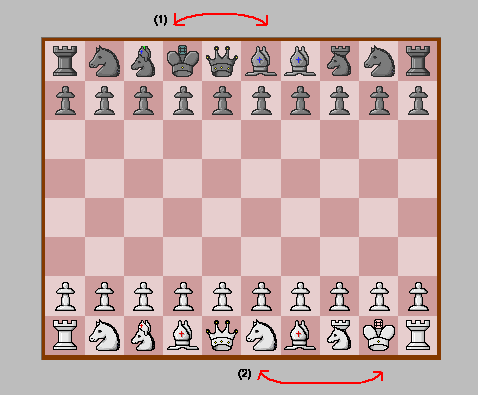
fig.1

fig.1
Abstract: The relocation method allows the players optionally to relocate either the king or queen before the play begins, whilst retaining the castling rights. The players can forgo this if they prefer the standard setup. The method enhances opening ramification, but also allows the players to remain in control. The resultant positions deviate marginally from the standard position and would be perceived as strategically sound by most chessplayers.
Introduction
Capablanca Relocation Chess builds on Capablanca's Chess, which is an invention of former World Champion José Raul Capablanca (1888-1942). The board is 8x10. Two new pieces are introduced (1) Archbishop (Princess/Cardinal) which slides like a Bishop or leaps like a Knight (2) Chancellor (Empress/Marshall) which slides like a Rook or leaps like a Knight. Castling is performed by jumping three squares with the King instead of two. Other rules are similar to ordinary chess. Piece setup: RNABQKBCNR
Capablanca Relocation Chess is like Capablanca Chess except that the players can, before play begins, swap places of the king/queen and another piece except the rooks. Thus, if the king is swapped (relocated), the other piece (the relocatee) ends up on the king's square. If the queen is swapped, the relocatee ends up on the queen's square. One restriction is that the bishops mustn't end up on the same square colour. Note that black begins by making the initial swap. Alternatively he can choose to leave the position as it is (by pressing the king). The white player then has the option to relocate his king or queen, whereupon he starts the game by making the first move. Each player can choose between 12 different setups, which results in 144 different board positions.
Note that the king retains his castling rights even if it has been relocated. The castling rules are simple and derive from Chess960. King and rook end up on their usual squares. The only difference is that the king can make longer leaps than usual (or shorter, or none at all). All squares between king and rook must be empty and unthreatened and neither of the pieces must have moved before. Castle on the queenside is denoted O-O-O. Castle on the kingside is denoted O-O.
Discussion
A famous regroupment occurred in the battle between Julius Caesar and Gnaeus Pompeius, where Caesar regrouped behind his lines. The maneuver was essential as he could counter the cavalry attack on the right flank, and this was also how he won the battle. My point is that regrouping is very natural in warfare, and that's why it belongs in chess, too.
I want to strike a blow for alternative setups of pieces. This will enhance creativity in chess, at least it's good for chess training. Black relocates first. Thusly white gets a chance to make a strategical decision that suits himself, which enables him to create an initiative, as in the standard position. The two parties may choose different setups. Remember that the resultant castling positions are always the same as in Capablanca's Chess.
Arguably, this method of reconfiguration of the initial array makes the procedure of randomization redundant (cmp. Fischer Random Chess). Thus it answers to the chessplayer's predilection for remaining in control.
Comments to fig. 1
Black has relocated the king to d8 and the relocatee to f8. White has relocated the king to i1, and the relocatee is thus placed on f1. Any party could have chosen to relocate the queen instead. White can later castle short by simply moving the rook to h8, or castle long by moving the king to c1, as usual. The latter alternative is less likely, however, while there are so many pieces placed in between. It's generally a good idea to remove the king from the centre, but white has thereby announced on which side the king is probably going to stay. Now white starts the game.
• You can download my free Capablanca Relocation Chess program here, but you must own the software Zillions of Games to be able to run it (I recommend the download version).
• See also Relocation Chess which uses the standard pieces and the 8x8 board.
• Don't miss my other chess variants.
© M. Winther (October 2009).